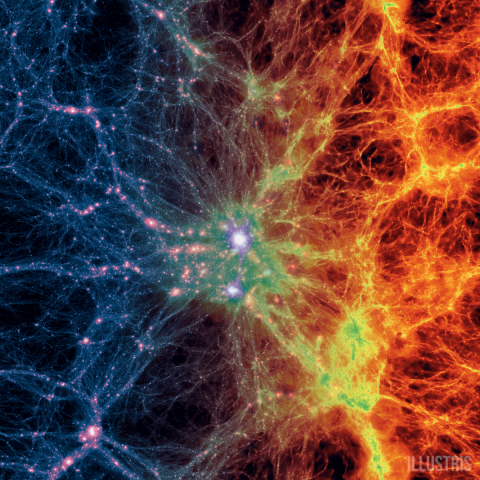Abstract: The canonical cosmological model, the Lambda Cold Dark Matter (ΛCDM) model, postulates that around 95% of the Universe consists of dark energy and Cold Dark Matter (CDM). Despite the unknown physical nature of these forms of matter and energy, the ΛCDM model provides accurate predictions for a variety of observations. One of the main pillars of cosmology is the large-scale distribution of galaxies as probed by galaxy surveys like the Sloan Digital Sky Survey (SDSS). The ultimate goal of this dissertation is to improve and apply methods to test the ΛCDM cosmological paradigm with state-of-the-art and future galaxy surveys.
A particular focus of this work is probing the cosmological paradigm with the matter and galaxy distribution on small, so-called non-linear scales. Among the most fundamental non-linear structures in cosmology are gravitationally collapsed, virialized dark matter halos. These halos provide the gravitational potential well for gas to condense and crystallize into galaxies. Studying the small-scale distribution of matter and galaxies thus requires a detailed characterization of the relationship between galaxies and dark matter halos, the galaxy-halo connection. Additionally, using non-linear scales comes with a plethora of additional challenges compared to large, so-called linear scales. However, non-linear scales have the strongest statistical constraining power, thus providing the largest potential insight into the galaxy-halo connection and cosmology. Therefore, this work is aimed at making measurements on non-linear scales a robust testbed for theories of galaxy formation and cosmology.
In detail, the topics covered in this dissertation are as follows: this work analyzes how often the brightest galaxies in a dark matter halo are located in the halo center in the SDSS. Additionally, a theoretical study of how the motions of satellite galaxies can be used to study the galaxy-halo connection is presented. Furthermore, this updated method based on the kinematics of satellite galaxies is then applied to the SDSS and its implications for galaxy formation discussed. Moreover, the small-scale clustering and galaxy-galaxy lensing signal of galaxies in the Baryon Oscillation Spectroscopic Survey (BOSS) is analyzed, as well as its implications for the ΛCDM paradigm and the galaxy-halo connection examined. Finally, a new, highly accurate statistical framework for studying cosmology with small-scale galaxy and matter distributions is discussed and demonstrated.
Advisor: Frank van den Bosch

